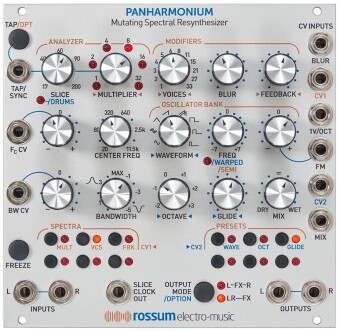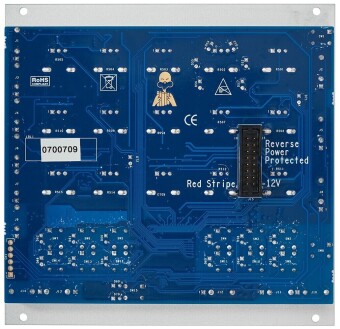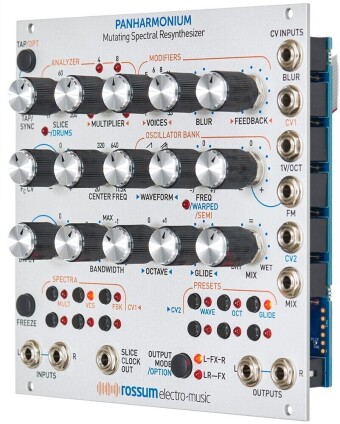Rossum Panharmonium



 59 810 р. предложить свою цену
42328
59 810 р. предложить свою цену
42328
Купить сейчас
Добавить в корзину
Уведомить о снижении цены
Уведомить о поступлении товара
Re-Synthesis - with the Rossum Panharmonium now also available in Eurorack! With the Panharmonium you can analyze the spectrum of any audio signal, convert it in real time and re-synthesize it with one to 33 oscillators. This really means EVERY audio signal: From the raw waveform of an oscillator to an entire mix. Our recommendation: vocal tracks and metallic percussion. When working with the Panharmonium, the realistic reproduction of sounds with resynthesis quickly becomes secondary, because the possibilities of changing and morphing the converted signal are immense and unheard of.
The Rossum Panharmonium was created by Bob Bliss, the creator of the EOS operating system of the Emulator sampler. The module is (in principle) capable of accurately reproducing the spectrum of a signal. But it is much more fun to use the analyzed signal as a starting point for experiments and to blur, limit, morph and freeze it.
It is also possible to take only one snapshot of a spectrum and work with the Panharmonium as a kind of complex harmonic oscillator (utilising all parameters of the resynthesis section).
The Panharmonium is an unexpected and powerful surprise that introduces completely new sound possibilities into the Eurorack cosmos.
The Panharmonium is divided into the following sections:
Spectral Analyzer
In this section the tools for the analysis process are provided. Via a signal at Tap/Sync input, Slice determines the rate/size of the blocks into which the incoming signal is divided. Center Freq and Bandwidth sets the frequency range of the band to be analyzed. Freeze allows the Panharmonium to remain on a slice. This is also the basis for the Spectra(memories).
Spectral Modifiers
This is the spectacular section of the module. Voice, Blur and Feedback allow drastic changes of the output signal. Voice controls the number of oscillators used, Blur controls the speed at which the spectrum changes, and Feedback returns the analyzed signal to the input.
Oscillator Bank
Both previous sections use the Oscillator Bank as a basis. The parameters are designed as you would expect from an oscillator: Waveform, Freq, Octave, Glide and Mix.
Spectra memories and Presets
There are 12 Spectra memories and 12 Preset memories. Spectra Memories are frozen slices/snapshots of a spectrum that replace the audio input and can be played like an oscillator (and manipulated with the sections). Presets are snapshots of the overall state of the panharmonium. Including all current values applied to the CV inputs.
To better understand the possibilities of the Panharmonium, here is a brief overview of the underlying synthesis forms:
Additive synthesis:
Each sound can be reproduced with a number of simple basic waveforms, preferably sine waves. Each of these basic oscillators does change in frequency and amplitude over time. If you want to reproduce a sound this way, you have to do a lot of work, because for a realistic reproduction you need a lot of oscillators. Because of this complexity, Additive Synthesis (this is how it is called) has never really become popular and is only found as a main feature in a few synthesizers, such as the completely underestimated but also dreaded Kawai K5000.
Resynthesis:
Resynthesis makes the process much easier: An audio signal is grabbed, split into bands and then converted into movements of amplitude and frequency of individual oscillators. Done in realtime this requires a lot of computing power and was reserved for DSP platforms like the Kyma or natively running VST plugins.
Since the signal is now available as a sum of individual base oscillators and their movements over time, there are completely new possibilities to work with the signal. This is the real strength of this synthesis form and thus also of the Panharmonium.
Заводская спецификация и комплектация с сайта производителя
The Rossum Panharmonium was created by Bob Bliss, the creator of the EOS operating system of the Emulator sampler. The module is (in principle) capable of accurately reproducing the spectrum of a signal. But it is much more fun to use the analyzed signal as a starting point for experiments and to blur, limit, morph and freeze it.
It is also possible to take only one snapshot of a spectrum and work with the Panharmonium as a kind of complex harmonic oscillator (utilising all parameters of the resynthesis section).
The Panharmonium is an unexpected and powerful surprise that introduces completely new sound possibilities into the Eurorack cosmos.
The Panharmonium is divided into the following sections:
Spectral Analyzer
In this section the tools for the analysis process are provided. Via a signal at Tap/Sync input, Slice determines the rate/size of the blocks into which the incoming signal is divided. Center Freq and Bandwidth sets the frequency range of the band to be analyzed. Freeze allows the Panharmonium to remain on a slice. This is also the basis for the Spectra(memories).
Spectral Modifiers
This is the spectacular section of the module. Voice, Blur and Feedback allow drastic changes of the output signal. Voice controls the number of oscillators used, Blur controls the speed at which the spectrum changes, and Feedback returns the analyzed signal to the input.
Oscillator Bank
Both previous sections use the Oscillator Bank as a basis. The parameters are designed as you would expect from an oscillator: Waveform, Freq, Octave, Glide and Mix.
Spectra memories and Presets
There are 12 Spectra memories and 12 Preset memories. Spectra Memories are frozen slices/snapshots of a spectrum that replace the audio input and can be played like an oscillator (and manipulated with the sections). Presets are snapshots of the overall state of the panharmonium. Including all current values applied to the CV inputs.
To better understand the possibilities of the Panharmonium, here is a brief overview of the underlying synthesis forms:
Additive synthesis:
Each sound can be reproduced with a number of simple basic waveforms, preferably sine waves. Each of these basic oscillators does change in frequency and amplitude over time. If you want to reproduce a sound this way, you have to do a lot of work, because for a realistic reproduction you need a lot of oscillators. Because of this complexity, Additive Synthesis (this is how it is called) has never really become popular and is only found as a main feature in a few synthesizers, such as the completely underestimated but also dreaded Kawai K5000.
Resynthesis:
Resynthesis makes the process much easier: An audio signal is grabbed, split into bands and then converted into movements of amplitude and frequency of individual oscillators. Done in realtime this requires a lot of computing power and was reserved for DSP platforms like the Kyma or natively running VST plugins.
Since the signal is now available as a sum of individual base oscillators and their movements over time, there are completely new possibilities to work with the signal. This is the real strength of this synthesis form and thus also of the Panharmonium.
характеристики
Скачать мануал Rossum Panharmonium
